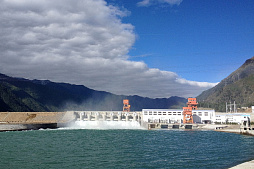To consider an application for financing, fill out the form and send it to us by e-mail along with the project brief, or contact our experts
Construction finance is associated with huge costs that project sponsors will have to incur long before the formation of stable cash flows from the project.
According to previous forecasts by Moody's, the global construction sector could grow to $ 8 trillion by 2030.
The most capital intensive is the construction of facilities such as hydroelectric power plants, heavy industrial plants, water treatment plants, LNG regasification terminals and mining facilities.
How to find funding sources?
When implementing the most ambitious environmental, energy, large industrial and infrastructure projects, you can rely on the professionalism of the LBFL team.
We provide financing and project management, as well as negotiate with banks, investors, subcontractors, suppliers, developers, authorities, etc.
However, the first step in any major project is to finance the construction. It is important not only to receive funds, but also to manage them correctly at every stage, from drawings to putting the facility into operation.
When planning the construction, modernization or expansion of a new facility, we must initially estimate its cost in order to start looking for funding sources. In addition to the purchase of the site, the costs will include obtaining official permits, the development and adaptation of technical documentation, the connection of utilities, the purchase and transportation of construction materials and special equipment, installation and general construction work.
Currently, few companies carry out the construction of large facilities entirely using their own assets.
Most often, such projects are implemented through bank loans, public-private partnerships and various models of project finance.
Many customers use multiple sources of funds in various combinations, which requires careful analysis and planning.
Investment costs for the construction of large industrial or energy facilities can be estimated based on preliminary studies, setting the final cost of the project in the EPC contract. Turnkey construction brings additional benefits to the customer, allowing the company to shift risks and responsibilities to an experienced general contractor.
We offer various models of construction finance for the following projects with a minimum contribution of the initiator (10% of the total investment):
• Solar power plants.
• Wind power plants.
• Hydroelectric power plants.
• Thermal power plants.
• Electrical substations.
• Wastewater treatment plants
• Waste processing plants.
• Metallurgical plants.
• Mining and processing plants.
• Mineral fertilizer plants.
• Sea ports and cargo terminals.
• LNG regasification terminals.
• Liquefied natural gas plants.
• Chemical plants.
• Cement factories, etc.
LBFL with international partners has successfully completed numerous projects in many countries around the world, including the European Union, the United States, Latin America, the Middle East and Africa.
If you need funds to develop your business, please contact us at any time.
Sources of finance in the construction industry
Construction finance sources can be classified based on the legal status of the capital provider in relation to the customer.Experts distinguish between internal funding and external funding.
Internal financing takes place when financial resources for construction are generated from the internal resources of an enterprise, including income from its commercial activities, sale or lease of unused assets, etc.
External financing of construction is attracted from other sources by issuing shares, obtaining a bank loan, attracting venture capital, etc. This is the most common source of financing for large projects in the energy, industry and infrastructure.
Debt financing and equity financing are also distinguished. In the first case, companies raise funds through debt instruments.
In the case of equity financing, the resources provided increase the equity capital of the enterprise, and the capital provider becomes the owner or co-owner of the business.
Reinvested profit
The reinvested profit is the profit retained within the company.This is one of the internal sources of capital that can be used for the growth and development of business, including construction finance.
The amount of profit received at the enterprise depends largely on the level of income and expenses.
In the case of joint stock companies, the profit earned by the company can be paid to the owners in the form of dividends or reinvested in new projects. Profit can be reinvested only if it remains within the company by the decision of the general meeting of shareholders and increases its capital.
This source of project financing is of little use for small companies that start ambitious projects with the expectation of future financial flows.

Issue of shares
One of the sources of financing for construction is the issue of shares.This action brings a number of significant benefits to the company. This allows reaching a wide range of investors, increasing the prestige and brand awareness, and also contributes significantly to increasing financial liquidity.
Shares are securities that give the right to participate in a joint stock company. Each share is a part of the capital of a joint stock company, which serves as proof of joint ownership of its assets. Registered shares can only be sold with a written statement from the owner and often with the consent of the company's management. Bearer shares can be sold without unnecessary formalities.
Due to the difference in the rights of a shareholder, ordinary shares and preferred shares can be distinguished.
Ordinary shares have low priority in the distribution of the company's profits and assets. The main factor motivating investors to buy common stock is the high return on investment, which outweighs the risk of potential losses.
Preferred shares give priority rights over the holders of ordinary shares in the distribution of profits and in the case of division of assets in the event of liquidation of the company.
Shares can be purchased by investors in the following ways:
• The primary securities market, where newly issued securities are traded for the first time by banks and other financial institutions. This is where the funds are formed that come to the issuer from the sale of shares.
• Secondary securities market, which sells already traded shares. Here resources are actually redistributed among active investors.
The issue of shares is associated with the constant acquisition of funds that have an impact on the increase in the company's capital.
The shares remain in circulation, but their owner may change, and hence the structure of the company's shareholders. Raising capital in this form is associated with significant costs for business, so the issue of shares is not suitable for every company.
Issue of bonds
The bond issue is an attractive alternative to other sources of construction finance, especially for businesses looking for significant capital for development.A bond is a security issued in series. With this paper, the issuer confirms that he is the debtor of the bond holder and is obliged to provide him with a certain financial benefit (bond redemption).
An issuer is defined as an entity that takes on capital market obligations by issuing bonds. Unlike shares, which give the right to participate in the assets of a company, a bond is a debt security.
From the moment a bond is issued to the moment of redemption, this security can change its owner many times. Each subsequent bond holder becomes the issuer's creditor.
The issue of convertible bonds is especially beneficial for projects with good growth prospects. By using this model, the founders of the company retain influence on the direction of its development at the beginning of the business. It is worth adding that the interest rate on convertible bonds may be lower compared to conventional bonds.
Table: advantages and disadvantages of bond issuance for business.
| Advantages | Disadvantages |
| A wide range of potential investors. | A strong position of the company is required. |
| Increasing the credibility of the company as a whole. | The need to return the principal with interest. |
| Most flexible models for repayment of principal and interest. | Long and difficult procedure. |
| Individual assessment of the attractiveness of the offer by investors. | High cost of financing. |
Securitization of assets
Asset securitization is an alternative source of financing for the construction of large projects.It is the process of issuing asset-based securities that provide stable financial flows for the holder.
A feature of securitization is that events related to the implementation of a specific program are isolated from the initiator of the project. Thus, the profit from securities is virtually independent of the financial condition of the company.
The list of participants in securitization includes:
• Investors.
• Initiator of the project.
• Special purpose vehicle (SPV).
• The entity organizing and controlling the transaction.
• Consultants (law firms or financial institutions).
• Underwriter, etc.
Securitization is a popular source of debt financing in developed markets.
It is the fastest growing area on the border of the capital market and the real economy in the United States and Western Europe.
Securitization assets must meet a number of criteria. In particular, the receivables must be fully repaid within the agreed period, the parties to the transaction must have an appropriate reputation, and the assets must be clearly diversified, for example, geographically.
The main advantage of securitization is the rapid conversion of low-liquid assets into cash. Securitization makes it possible to improve the financial position and ensure the continuity of financing for the construction of important projects.

Mezzanine capital
Mezzanine finance is a model that sits between classic debt and equity.This type of financing combines elements of classic debt and equity instruments, allowing companies to use financial leverage.
Unsecured and overly subordinated mezzanine finance is quite expensive as lenders expect above average returns from projects. A mezzanine is a type of debt in which the capital provider gets the right to participate in the capital of the company or in the profit of the financed project.
Mezzanine construction finance is intended for enterprises that already have a history of successful operations, since in this situation the risk is lower than in business at the initial stage of growth.
This source of corporate finance is an alternative to traditional sources that are inaccessible to enterprises due to insufficient creditworthiness.
Venture capital
Venture capital can be defined as equity capital invested over a limited period of time by external investors in small (medium) companies with the aim of implementing a unique, innovative project.On the one hand, such projects carry a high risk of investment failure, but on the other hand, they can provide high expected returns due to the increase in the cost of the invested capital over time.
Venture funds are primarily focused on financing companies at an early stage of development.
Investments of this type are characterized by a medium and long term time horizon. The funds obtained in this way are intended, in particular, to finance the construction of new facilities, new products, technologies, increase working capital, expand sales channels, etc.
The idea of venture funding is not based on the product or service itself, but on the concept of a business venture with the potential for rapid growth.
An example of the impact of venture capital is the creation of the computer company Digital Equipment Corporation in 1957 for $ 100,000. After the launch of the company's shares to the public in 1972, the value of this company increased to $ 490 million.
Business angels
A business angel is an individual who has decided to invest their private funds in an enterprise with high potential for growth.Business angels are most often ambitious, risk-averse entrepreneurs with significant professional achievements and significant personal assets that allow them to finance businesses at the start-up stage.
As a rule, business angels provide financing, expecting a high return on investment. Financing the construction of innovative projects is extremely important for the dynamic development of young businesses.
Such a transaction is made in exchange for receiving part of the company's shares and, thus, for participation in future profits.
Construction loans
When planning to attract bank financing, it is extremely important to choose the right bank.When concluding a loan agreement, the bank undertakes to provide the borrower with funds for the construction of the facility for a specified period. In turn, the borrower undertakes to use this money on the terms specified in the contract, returning the entire amount with interest at maturity with payment of a commission.
Below are the additional costs associated with obtaining a bank loan for construction:
• Interest rate on the loan determined by the agreement.
• Payment for registration of banking services.
• Additional costs, including fee for extending the term of the loan agreement.
A construction loan can be obtained by individuals, legal entities, as well as business entities without legal personality.
The bank will determine the possibility of providing a loan, its size and other terms of the agreement, depending on certain factors, including:
• The creditworthiness of the borrower, that is, the ability to repay the loan together with interest within the terms specified in the agreement.
• The result of the assessment of the technical documentation of the project and the financial information of the borrowing company.
Table: advantages and disadvantages of construction loans
| Advantages | Disadvantages |
| Relatively low financing costs. | Strict criteria and additional conditions. |
| A wide range of commercial offers from banks. | A positive rating of the company is required. |
| Negotiation of financing terms. | The need for regular payments. |
| A standardized model for assessing the creditworthiness of a borrower. | High entry threshold due to formalities and the collection of the necessary documentation. |
The international company LBFL works closely with the largest commercial banks in Spain, investment funds and other European financial institutions.
We are always ready to assist your business in obtaining a loan for large energy, environmental, industrial or infrastructure projects in Europe and beyond.

Leasing to finance construction
Leasing is widely recognized as an attractive method of financing investment projects.It is a mixed form of contracts such as lease and purchase in installments, but formally leasing cannot be equated with any of the above types of relationships.
The essence of leasing is to give the investor the opportunity to use certain assets (cars, vehicles, devices, real estate and entire businesses) and benefit from them without becoming their owner.
The benefits of leasing to finance construction include:
• Lack of initial investment in construction.
• Ability to finance most or all of the costs.
• Flexible choice of terms of the deal for the individual needs of the participants.
• Reduced overall investment costs as transaction fees may be less significant.
• Expansion of credit opportunities.
• Tax incentives, etc.
As can be seen from the above list, the list of benefits from using leasing as a source of construction finance is much higher than the risk arising from the performance of a lease agreement.
Features of factoring
Factoring is another external source of corporate finance.The main subject of factoring is the assignment of receivables, the essence of which is the right to receive cash payment for the delivery, work or performance of the service within a certain period.
There are also additional services related to factoring:
• Debt collection.
• Sending reminders to the overdue debtors.
• Periodic examination of the financial situation of debtors.
• issuance of loans related to the factoring agreement.
• Settlement of relations between the parties to the transaction.
• Planning the development of the company and so on.
Factoring is a form of financing created to solve cash flow problems that arise when a debt is not collected on time or it is not possible to offer your recipients suitable payment terms.
But there are also niches in construction where factoring is used, including the supply of building materials and equipment.
Construction finance: what is the best model?
The construction financing issue applies to both start-up companies and those that have been on the market for years. However, the greatest need for financial resources is demonstrated by enterprises during the period of rapid growth.
The construction of large power plants, waste water treatment plants, heavy industry and infrastructure facilities is capital intensive and therefore requires significant external funding.
The need for financial resources depends on the type of activity and the concept of the company's development. Achievement of satisfactory results in the carried out business activity is possible due to the correctly carried out organizational, management and control measures in the field of finance.
The selection of an appropriate funding model should begin with an analysis of the availability of the selected source of funds. There are certain limitations in this matter, which are mainly related to internal factors, the legal form of the enterprise, business reputation, size, financial position and other factors.
LBFL provides professional services related to financial modeling, finding investors, obtaining loans, engineering design, construction and technical support.
Contact our consultants to learn more about our offers.




























